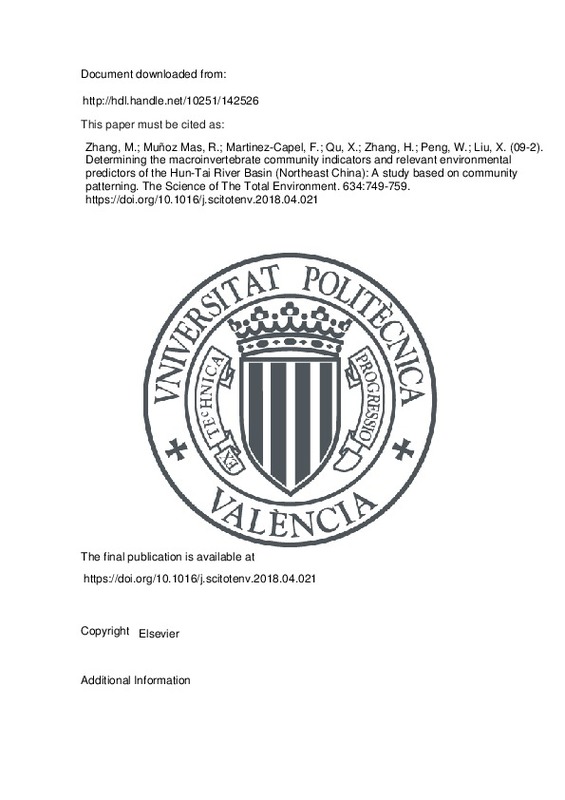JavaScript is disabled for your browser. Some features of this site may not work without it.
Buscar en RiuNet
Listar
Mi cuenta
Estadísticas
Ayuda RiuNet
Admin. UPV
Determining the macroinvertebrate community indicators and relevant environmental predictors of the Hun-Tai River Basin (Northeast China): A study based on community patterning
Mostrar el registro sencillo del ítem
Ficheros en el ítem
| dc.contributor.author | Zhang, Min
|
es_ES |
| dc.contributor.author | Muñoz Mas, Rafael
|
es_ES |
| dc.contributor.author | Martinez-Capel, Francisco
|
es_ES |
| dc.contributor.author | Qu, Xiaodong
|
es_ES |
| dc.contributor.author | Zhang, Haiping
|
es_ES |
| dc.contributor.author | Peng, Wenqi
|
es_ES |
| dc.contributor.author | Liu, Xiaobo
|
es_ES |
| dc.date.accessioned | 2020-05-06T07:18:42Z | |
| dc.date.available | 2020-05-06T07:18:42Z | |
| dc.date.issued | 2018-09 | es_ES |
| dc.identifier.issn | 0048-9697 | es_ES |
| dc.identifier.uri | http://hdl.handle.net/10251/142526 | |
| dc.description.abstract | [EN] It is essential to understand the patterning of biota and environmental influencing factors for proper rehabilitation and management at the river basin scale. The Hun-Tai River Basin was extensively sampled four times for macroinvertebrate community and environmental variables during one year. Self-Organizing Maps (SOMs) were used to reveal the aggregation patterns of the 355 samples. Three community types (i.e., clusters) were found (at the family level) based on the community composition, which showed a clearly gradient by combining them with the representative environmental variables: minimally impacted source area, intermediately anthropogenic impacted sites, and highly anthropogenic impacted downstream area, respectively. This gradient was corroborated by the decreasing trends in density and diversity of macroinvertebrates. Distance from source, total phosphorus and water temperature were identified as the most important variables that distinguished the delineated communities. In addition, the sampling season, substrate type, pH and the percentage of grassland were also identified as relevant variables. These results demonstrated that macroinvertebrates communities are structured in a hierarchical manner where geographic and water quality prevail over temporal (season) and habitat (substrate type) features at the basin scale. In addition, it implied that the local-scale environment variables affected macroinvertebrates under the longitudinal gradient of the geographical and anthropogenic pressure. More than one family was identified as the indicator for each type of community. Abundance contributed significantly for distinguishing the indicators, while Baetidae with higher density indicated minimally and intermediately impacted area and lower density indicated highly impacted area. Therefore, we suggested the use of abundance data in community patterning and classification, especially in the identification of the indicator taxa. (C) 2018 Elsevier B.V. All rights reserved. | es_ES |
| dc.description.sponsorship | This work was supported by the National Natural Science Foundation of China (51779275, 41501204, 51479219) and the IWHR Research & Development Support Program (WE0145B532017). | es_ES |
| dc.language | Inglés | es_ES |
| dc.publisher | Elsevier | es_ES |
| dc.relation.ispartof | The Science of The Total Environment | es_ES |
| dc.rights | Reconocimiento - No comercial - Sin obra derivada (by-nc-nd) | es_ES |
| dc.subject | Macroinvertebrate patterning | es_ES |
| dc.subject | Indicators | es_ES |
| dc.subject | Self-Organizing Map | es_ES |
| dc.subject | Decision tree | es_ES |
| dc.subject | River zonation | es_ES |
| dc.subject.classification | TECNOLOGIA DEL MEDIO AMBIENTE | es_ES |
| dc.title | Determining the macroinvertebrate community indicators and relevant environmental predictors of the Hun-Tai River Basin (Northeast China): A study based on community patterning | es_ES |
| dc.type | Artículo | es_ES |
| dc.identifier.doi | 10.1016/j.scitotenv.2018.04.021 | es_ES |
| dc.relation.projectID | info:eu-repo/grantAgreement/NSFC//51779275/ | es_ES |
| dc.relation.projectID | info:eu-repo/grantAgreement/NSFC//41501204/ | es_ES |
| dc.relation.projectID | info:eu-repo/grantAgreement/NSFC//51479219/ | es_ES |
| dc.relation.projectID | info:eu-repo/grantAgreement/IWHR//WE0145B532017/ | es_ES |
| dc.rights.accessRights | Abierto | es_ES |
| dc.contributor.affiliation | Universitat Politècnica de València. Instituto de Investigación para la Gestión Integral de Zonas Costeras - Institut d'Investigació per a la Gestió Integral de Zones Costaneres | es_ES |
| dc.contributor.affiliation | Universitat Politècnica de València. Departamento de Ingeniería Hidráulica y Medio Ambiente - Departament d'Enginyeria Hidràulica i Medi Ambient | es_ES |
| dc.description.bibliographicCitation | Zhang, M.; Muñoz Mas, R.; Martinez-Capel, F.; Qu, X.; Zhang, H.; Peng, W.; Liu, X. (2018). Determining the macroinvertebrate community indicators and relevant environmental predictors of the Hun-Tai River Basin (Northeast China): A study based on community patterning. The Science of The Total Environment. 634:749-759. https://doi.org/10.1016/j.scitotenv.2018.04.021 | es_ES |
| dc.description.accrualMethod | S | es_ES |
| dc.relation.publisherversion | https://doi.org/10.1016/j.scitotenv.2018.04.021 | es_ES |
| dc.description.upvformatpinicio | 749 | es_ES |
| dc.description.upvformatpfin | 759 | es_ES |
| dc.type.version | info:eu-repo/semantics/publishedVersion | es_ES |
| dc.description.volume | 634 | es_ES |
| dc.identifier.pmid | 29649719 | es_ES |
| dc.relation.pasarela | S\370094 | es_ES |
| dc.contributor.funder | National Natural Science Foundation of China | es_ES |
| dc.contributor.funder | China Institute of Water Resources and Hydropower Research | es_ES |







![[Cerrado]](/themes/UPV/images/candado.png)

